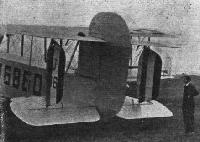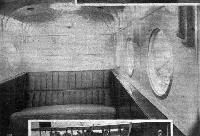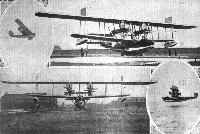Фотографии
-
A FRENCH RECORD-BREAKER: The Farman "Goliath" fitted with floats on which Georges Rene established a world's altitude record for seaplanes carrying a useful load of 1,000 kgs., at St. Raphael on April 4. In a flight lasting 1 hr. 20 mins. he reached an altitude of 3,300 m., thus beating the previous record of 2,432 m. made by E. Dolecek (U.S. Air Service) on an F-5-L flying boat. The above "Goliath" is fitted with two 230 h.p. C.U.Z.9 Salmson engines.
Самолёты на фотографии: Farman F.60 Goliath / F.169 - Франция - 1918
-
Регистрационный номер: J6860 [3] One of the Napier "Lion" Engines of the "Awana": Standing in front of the machine is Mr. Frank Courtney who tested the "Awana" for the makers.
Самолёты на фотографии: Armstrong Whitworth Awana - Великобритания - 1923
-
Регистрационный номер: J6860 [3] The tail planes of the "Awana."
Самолёты на фотографии: Armstrong Whitworth Awana - Великобритания - 1923
-
Регистрационный номер: J6860 [3] THE "AWANA": Side view of machine with wings folded. Note clean lines of engine nacelles.
Самолёты на фотографии: Armstrong Whitworth Awana - Великобритания - 1923
-
THE ARMSTRONG-WHITWORTH "AWANA": Some constructional details. - 1. Shows a typical fuselage fitting. In 2 is seen the hinge locking pin, spar boxes, etc., at the junction of the centre-section with the end pieces of the top plane spar. 3 shows more or less in diagrammatic form the type of bracing employed in the fuselage structure.
Самолёты на фотографии: Armstrong Whitworth Awana - Великобритания - 1923
-
Armstrong Whitworth "Awana" Troop Carrier 2-450 hp Napier "Lion" Engines
Самолёты на фотографии: Armstrong Whitworth Awana - Великобритания - 1923
-
Four views of the Boeing Pursuit Biplane (500 h.p. Curtiss D-12 engine), a number of which have been supplied to the U.S. Army Air Service. It has a speed range of 60-165 m.p.h.
Самолёты на фотографии: Boeing PW-9 / FB / P-7 / P-8 - США - 1923
-
Регистрационный номер: J6997 A BRISTOL "AMBULANCE" AEROPLANE: Our photographs show the new Bristol specially arranged for Red Cross work. The large cabin, white enamelled throughout, measures 10 ft. 6 ins. in length, and is 5 ft. 9 ins. high and 4 ft. wide. The large windows can be opened along the entire length of both sides so as to give ample ventilation even in hot climates. Two stretcher cases and four sitting cases can be carried, or the accommodation can be varied to allow of three of the passengers being accommodated on stretchers. A wide entrance has been made in the port side, opposite the main entrance door, which is on the starboard. The engine fitted is a Bristol "Jupiter" of 400 h.p.
Самолёты на фотографии: Bristol Ten-Seater / Brandon - Великобритания - 1921
-
Регистрационный номер: G-EAQT CONVERTED F5 FLYING BOAT: A couple of years ago Short Brothers built this machine for Mr. Lebbeus Hordern of Australia for his private use, and the machine has'done good service as an aerial yacht. Mr. Hordern has now ordered the small all-metal flying boat. In the top photograph may be seen the pontoons used by Shorts in getting into and out of their seaplanes, loading up with fuel, etc. The flying boat is brought between the pontoons, and hull as well as engines can be easily reached.
Самолёты на фотографии: Felixstowe F.2 - F.5 - Великобритания - 1917
-
CONVERTED F5 FLYING BOAT: A couple of years ago Short Brothers built this machine for Mr. Lebbeus Hordern of Australia for his private use, and the machine has'done good service as an aerial yacht. Mr. Hordern has now ordered the small all-metal flying boat. The view shows a portion of the roomy cabin.
Самолёты на фотографии: Felixstowe F.2 - F.5 - Великобритания - 1917
-
Регистрационный номер: G-EBJY [2] THE NEW SUPERMARINE AMPHIBIAN FLYING BOAT: View of the machine taking off and, inset, in the air.
Самолёты на фотографии: Supermarine Swan - Великобритания - 1924
-
Регистрационный номер: G-EBJY [2] A NEW SUPERMARINE AMPHIBIAN FLYING BOAT: This machine, fitted with two Rolls-Royce "Eagle" engines, has been built for the Air Ministry, and it is not permissible to give technical details. The main features of the design will, however, be evident from the illustrations. Capt. Biard took the machine out recently, and, after a short taxying test which proved the machine to be satisfactory, he took off and carried out a flying test of 45 minutes' duration. An unusual feature of the design is the raised, or "coach-roof" cabin top. The high flaring bows should render the boat capable of riding out quite a heavy sea.
Самолёты на фотографии: Supermarine Swan - Великобритания - 1924
-
THE U.S. NAVY C.S. "THREE-PURPOSE" BIPLANE: A convertible land or seaplane (650 h.p.,Wright T.2 engine), suitable for bombing, torpedo-launching, and long-range scouting.
Самолёты на фотографии: Curtiss CS - США - 1923
-
CEDRIC LEE No.1 machine. Front view.
Самолёты на фотографии: Lee-Richards annular monoplane - Великобритания - 1913
-
Side view of Cedric Lee machine No.3.
Самолёты на фотографии: Lee-Richards annular monoplane - Великобритания - 1913
-
Rear view of Cedric Lee machine No. 3.
Самолёты на фотографии: Lee-Richards annular monoplane - Великобритания - 1913
-
Регистрационный номер: G-EBKA [2] THE SHORT LIGHT FLYING BOAT: View of the hull, showing steps, etc.
Самолёты на фотографии: Short Stellite / Cockle / S.1 - Великобритания - 1924
-
Регистрационный номер: G-EBKA [2] THE SHORT LIGHT FLYING BOAT: The duralumin hull on the water. After being moored out for 24 hours only an egg-cup full of water had leaked in.
Самолёты на фотографии: Short Stellite / Cockle / S.1 - Великобритания - 1924
-
THE SHORT LIGHT FLYING BOAT: Two views of a scale model of the machine. These give a good idea of the general appearance and "clean" lines.
Самолёты на фотографии: Short Stellite / Cockle / S.1 - Великобритания - 1924
-
Short All Metal Light Flying Boat 2-696 c.c. Blackburne Engines
Самолёты на фотографии: Short Stellite / Cockle / S.1 - Великобритания - 1924
-
THE HANRIOT H-D-26 'SESQUIPLANE": A single-seater chaser of all-metal construction. The "plus fours" on the chassis struts are radiators.
Самолёты на фотографии: Hanriot H.26 - Франция - 1923
-
FOUR. VIEWS OF THE FAIREY "ATALANTA": This machine, which is equipped with four 700 h.p. Rolls-Royce "Condor" engines, is probably the largest flying boat actually in,commission. The type is known as, an Open Sea Reconnaissance flying boat.
Самолёты на фотографии: Fairey N.4 Atalanta - Великобритания - 1923
-
Регистрационный номер: G-EBHO THE WORLD-FLIGHT: A few more pictures from the start at Calshot, on March 25. 1. Three-quarter rear view of the Vickers "Vulture." 2. Interested visitors to Calshot: Lieut.-Col. Darby, Mr. Harold Perrin, and Mr. H. T. Vane, of Napier Engine fame. 3. Squadron-Leader MacLaren gives his cine camera a "trial run." 4. Taking on board stores for the journey. 5. The mascot which MacLaren would have liked to have taken: The daughter of the leader of the expedition tries the "mascot's seat." Her little brother is an interested on-looker.
Самолёты на фотографии: Vickers Vulture / Vanellus - Великобритания - 1924
-
AN AMERICAN THREE-SEATER COMMERCIAL BIPLANE: The "Swallow," 1924 model, fitted with a 90 h.p. Curtiss OX5 engine.
Самолёты на фотографии: Swallow New Swallow - США - 1924
Статьи
- Flight























